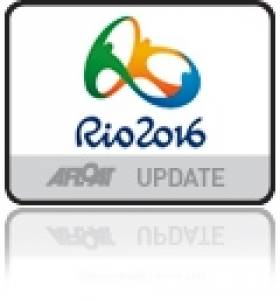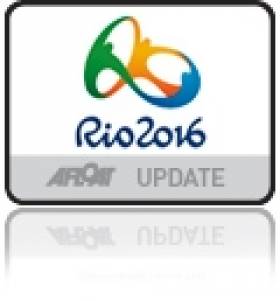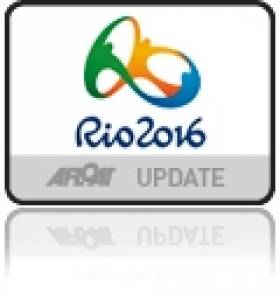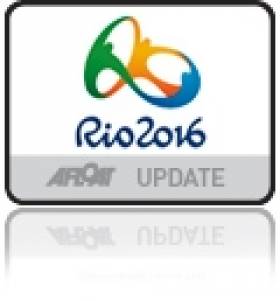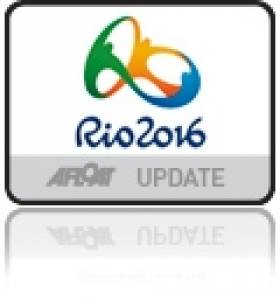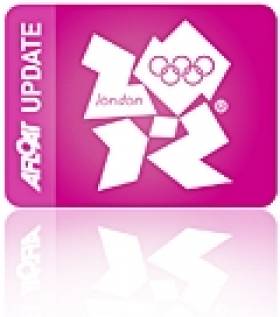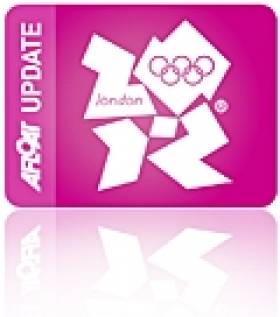Displaying items by tag: 49er
#olympicsailing – Irish Olympic duo Ryan Seaton and Matt McGovern finished 26th overall yesterday at the 49er European championships in Denmark.
Thusgaard Olsen are Denmark's latest sailing sensations after they became the SAP 49er FX European champions on Sunday on the bay where they learned to sail as seven year olds, 13–years ago. Results here.
Both women's Irish 29er pairings Tiffany Brien and Saskia Tidey and Claudine Murphy and Andrea Brewster found the going tough in Aarhaus, finishing at the back of the silver fleet. Results here.
It was a momentous day for the 49ers and Olympic sailing generally too with a fantastic example of the 'theatre style' racing close to the shore. Aarhus's weather gods delivered on cue with a sea breeze allowing the short course, 500 metres long by 200 metres wide, to be laid perpendicular to the long promenade where the crowd basked in glorious sunshine. For the spectators and for television it made what can seem a remote sport exciting and understandable. Sport Event Denmark, Sailing Aarhus and Sport Aarhus Events have yet to confirm whether are bidding for the 2018 ISAF world championships, but if they do, this will provide a powerful case study.
There was a dramatic backdrop too as the Aarhus has been simultaneously hosting the start of The Tall Ships Race. The compact city has happily handled the hundreds of thousands of people flooding into the harbour over the weekend.
The men's races went down to the wire. But after their capsize, New Zealand's Peter Burling and Blair Tuke, the Olympic silver medalists, showed champion calm and skill. They won the next race and with the points level with Britain's Dylan Fletcher and Alain Sign going into the last race, they got a good start and were able to get ahead of the British and manage them for the whole race. The French pair of Julien d'Ortoli and Noe Delpech took bronze. It was the second New Zealand medal of the day after Alexandra Maloney and Molly Meech won a hard-fought bronze in the women's FX.
Results:
SAP men's 49er European Championships
1. Peter Burling and Blair Tuke, 89 points
2. Dylan Fletcher and Alain Sign, 93
3. Julien d'Ortoli and Noe Delpech, 112
SAP women's 49er FX European Championships
1. Ida Marie Baad Nielsen and Marie Thusgaard Olsen, 87
2. Martine Soffiatti Grael and Kattena Larsen Kunze, 104
3. Alexandra Maloney and Molly Meech, 108
#49er – A credible top ten performance at Kiel week this week for Northern Ireland's 49er pairing Ryan Seaton and Matt McGovern marks another auspicious step on the ladder for Rio 2016, given this is only the dinghy pairs second regatta since returning from London 2012.
This week's German result follows Sail for Gold victory in Weymouth a fortnight ago and positions the Ballyholme duo well for this month's 49er Europeans, the main target of their summer campaign. The pair finished seventh overall in a Kiel fleet of 51–boats, recovering from some mid-fleet performances earlier in the series.
Belfast team mate James Espey did not fare as well in the mens Laser division finishing 60th out of 92 starters.
Tiffany Brien, also from Belfast lough, now teamed with Dubliner Saskia Tidey were 12th from 15 in the brand new 49er fx women's Olympic class. This pair are also heading for a class European championships.
Full results in each class of Irish interest is downloadable below
Irish 49er & 49erFX Crews Back in Action at Kiel Week
#kielewoche – Last week's Olympic classes Sail for Gold Regatta Gold medallists, Northern Ireland's Ryan Seaton and Matt McGovern, are in action again this weekend at Kiel Regatta in Germany.
Racing begins on Saturday with a total of 19 races over five days. The skiff pair pair will have gained confidence from their recent victory but bigger prizes are on the horizon and immediately after Kiel travel to Aarhus in Denmark for the 49er European Championships.
There they will, for the first time since the 2012 Games, compete against a full international 49er 'A fleet'.
Also in action, in the new Olympic 49er FX female class, are Olympic newcomers Tiffany Brien and Saskia Tidey who make their European Championship debut also in Denmark next week.
Fellow Belfast lough sailor James Espey is also in action the Laser class.
Ryan Seaton and Matt McGovern have kick-started their Rio 2016 campaign in the most convincing fashion with a Gold medal at the Sail for Gold Regatta in Weymouth this afternoon.
The breakthrough performance is the first international medal for the Belfast lough duo who beat numerous World and European medallists in the process.
This is London 2012 pairing's first major event since competing at the venue a year ago, when Weymouth played host to the Olympic regatta.
Going into today's medal races, the pairing had a six point lead but could have been overtaken by any of the top 10 as three double point races were scheduled. In the end, they sealed victory in style extending their lead as Afloat.ie reported earlier posting a third and a second respectively in the two medal races.
Irish 49er Pairing in First Place at Sail for Gold Regatta
#sailforgold – London 2012 49er Irish pairing Ryan Seaton and Matt McGovern have made a great return to the Olympic circuit this week at Sail for Gold Regatta in Weymouth. The Irish 49er team are beating some heavyweight competitors and holding first place by a margin of six points.
In a complete change of conditions in Weymouth Bay there was an average of 20–knots blowing across Portland Harbour largely suiting the Irish fleet on the Dorset coast.
A strong performance from Annalise Murphy moves her into the top five overall with two more fleet races to go but it was the stand out performance of China's Lijia Xu that has impressed many at the former Olympic venue. The Olympic Gold medallist now has a ten point margin over countrywoman Dongshuang Zhang.
In the best day so far for 49erfx campaigners Tiffany Brien and Saskia Tidey they secured top 5 results in today's stronger conditions. They move up two places to sixth overall.
Laser sailor James Espey remains in the middle of the Laser fleet following four races.
Irish youth laser radial sailors Séafra Guilfoyle, Finn Lynch, Fionn Leyden and Cian Byrne are still holding on to their top ten spots.
Annalise Sails for Three Out of Three as Irish Sailors Head for Sail for Gold, Weymouth
#SailforGold– Irish Olympic Sailing sensation Annalise Murphy is back in Weymouth to make it three out of three in the Eurosaf Champions Sailing Cup series after already taking gold at the first two events in Italy and Holland.
She is joined by four of her London 2012 Olympic team mates this weekend to begin competing at the Sail for Gold Regatta. Murphy (Laser Radial) is joined by Ryan Seaton and Matt McGovern (49er) and James Espey (Laser) will begin racing on Sunday in what will be the third of five EUROSAF installments
This will be the first regatta of the 2013 season for Seaton and McGovern who finished 14th overall at the Games last year. Back in familiar waters after months of physical and mental training, the duo are eager to once again feel the adrenaline of elite competition as they begin their campaign towards the Rio 2016 Olympics. Up against some of the top international 49er teams, the Northern Irish men will be looking to shake off the cobwebs after an extended break from competition.
Also campaigning for the Rio Games and competing for the first time in the 49er FX class will be two new all-female pairings. Claudine Murphy, older sister of Annalise, has teamed up with Andrea Brewster while Tiffany Brien and Saskia Tidey, will be sailing the other Irish entry for the new Olympic class.
Lifeboat Rescues 49er Dinghy Crew on Dublin Bay
#rescue – The crew of an Olympic 49er skiff dinghy that capsized off Dun Laoghaire in strong winds this morning has been brought to safety by Dun Laoghaire lifeboat.
The two dinghy sailors got into difficulties in strong winds on Dublin Bay.
The pair were training on a 49er skiff dinghy and departed the harbour mid-morning. They had been attempting to return for two hours but repeatedly capsized close to the harbour entrance.
A concerned member of the public walking on the pier had kept the dinghy under observation for about 20 minutes before reporting the situation.
The Irish Coastguard Marine Rescue Co-Ordination Centre (MRCC) Dublin requested that the RNLI Inshore lifeboat (ILB) launch but it was subsequently decided to task the All-Weather lifeboat (ALB) due to the deteriorating conditions and moderate visibility. The South-Easterly wind was gusting in excess of 30 knots.
The lifeboat launched at 12.20 and immediately located the casualty heading for the more sheltered area off Seapoint under reduced sail. The boat was taken in tow to the Coal Harbour slipway. Neither crew-member needed medical attention.
No Medal Race for Irish 49er Campaign
#49er – Ireland's 49er Belfast skiff campaign has ended without the much hoped for medal race participation.
Today's last day of fleet racing was Ryan Seaton and Matt McGovern's last opportunity to hold on to a top ten position before next Wednesday's medal race.
The pair were tenth overall heading in to Race 14 but only four points separated them from 13th place. Seaton and McGovern finished in 16th which saw them drop to 11th overall. Sadly Race 15 had an equally frustrating ending, seeing the pairing finish in 16th and 14th overall ultimately ending their dreams of racing in the medal race.
Irish 49er Duo Take a Rest in 11th Overall
#49er – Ryan Seaton and Matt McGovern dropped out of the top ten of the 49er skiff class yesterday after their fifth consecutive day of racing to be 11th overall as the fleet pause for a rest today.
The Belfast pair had three races this afternoon taking 14th, 7th and 15th respectively. Race ten was one of their most impressive races of the event. Even though they ultimately finished in 7th place, they held their own with the best in the world shifting from 4th to 5th place and keeping ahead of the overall leaders; Outteridge and Jensen (AUS) until the very end of the race. Seaton and McGovern are currently 11th overall on 97 points.
The Australians, Outteridge and Jensen, hold the lead on 42 points followed by Burling and Tuke (GBR) on 51 and Lehtinen and Bask (FIN) on 66 points. The 49er class have a rest day today and resume on Sunday.
Irish 49er Pair Claim Race Win at Sail for Gold (Video)
#sailforgold – Northern Ireland sailors Matthew McGovern and Ryan Seaton have made a good start at the Skandia Sail for Gold Regatta as they fine-tune their preparations for the Olympic Games.
The 49er class duo raced three times on the opening day at the Olympic venue in Weymouth, and claimed first place in the final race of the day.
After finishing eighth and 11th earlier, they are ranked ninth overall going into day two.
McGovern, 27, and Seaton, 24, qualified the nation in December at the World Sailing Championships in Australia, and London 2012 will be the first time since Athens 2004 that Ireland have been represented in the 49er event.
McGovern admits they are treating Sail for Gold as a dress rehearsal for the main event in under two months' time.
"We are trying to make this a bit like the Games with the atmosphere and personnel that are around, so we just trying to put a nice consistent solid week in," he said.
"The aim yesterday was just to make sure we didn't lose the regatta on the first day and I think the last race really paid off.
"We are trying to decide our final mast for the Games. We won't use our Games boat here but we will use our mast that we think we will probably want to use.
"We are doing a lot of tuning on that, so it's good from that point of view to be out with the other boats and race against them in the kind of conditions we hope to get in the Olympics.
"It looks like we are going to have a nice windy week later on which will be really good to check the rigging with that.
"Knowing that in eight weeks we will be back and it will be race time is really good.
"It's a really different regatta with a different vibe to it, and the whole being up in London for the opening ceremony is going to be pretty insane and we are really looking forward to it."
For more news on the Irish Olympic Sailing Team
For more: www.skandiateamgbr.com. Investment specialist Skandia is the principal sponsor of the British sailing team.


























